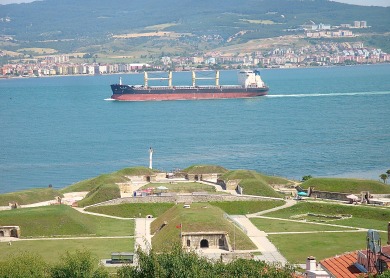As you cross the water towards Kilitbahir you will see, picked out on the hillside, a verse written by Necmettin Halil Onan to commemorate the bloody struggle that took place near here in 1915 and that ended with an estimated 55,000 Turkish and 36,000 Allied deaths. Translated, it reads: ‘Traveller, halt! The soil you heedlessly tread once witnessed the end of an era. Listen! In this quiet mound there once beat the heart of a nation.’
Given the importance of the stretch of water that separates Çanakkale from Kilitbahir, it’s hardly surprising that it has spawned any number of curious fables.
The first such story explains why the Dardanelles is also called the Hellespont (Helle’s Bridge) and involves the Golden Fleece, in search of which Jason and the Argonauts later travelled the length of the Black Sea. Bribed by a scheming step-mother, an oracle had ordered the King of Thessaly to sacrifice his eldest son. At the last moment the god Hermes answered the real mother’s prayers and sent a golden-fleeced ram to carry her son and daughter to safety on the Asian side of the straits. Unfortunately mid-flight Helle tumbled off and drowned, whereupon the straits took on her name.
Better known is the story of the lovers Hero and Leander. Leander was a young man from Abydos, near Çanakkale, Hero a priestess from Sestos. Every night she would set a light in her window and Leander would swim across to visit her. Then one night a storm blew out the light and, led astray, Leander drowned. Grief-stricken, Hero threw herself from a tower and died.
Until 1810 Leander’s was assumed to have been a fictitious feat but then the great romantic poet, Lord Byron, arrived in Çanakkale and proved otherwise, swimming across the strait in an hour and ten minutes. Since then many other swimmers have emulated his accomplishment on 30 August when shipping is briefly halted to enable them to cross. Local travel agencies help make the necessary arrangements.

Around town
Although the castle and fortifications overlooking the harbour are the most obvious reason to visit Kilitbahir this is actually a pretty little place (much nicer than Eceabat, for example) and it’s worth climbing the hill behind the castle to discover narrow cobbled streets with a few remaining Ottoman houses and at least one fine early 18th-century fountain commissioned by Damad Ibrahim Pasa, the powerful vizier and son-in-law of Sultan Ahmed III.
Here, too, you’ll find the shrine of Edirne-born Cahidi Ahmed Efendi (? -1659), who founded the Cahidiyye branch of the powerful Sufi sect, the Halvetiyyes (Khawaltis).
Day trip destinations


